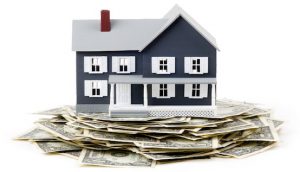
How to save enough money for a down payment on a home

House on a heap of money
Saving up a down payment to buy your first house can seem a pretty daunting task. If you’ve never had more than a few thousand dollars in the bank at any given time, then setting aside five figures or more may seem impossible.
However, getting a down payment together is not as difficult as you may think — if you go about it the right way.
Figure out how much house you can afford
The first step in saving up your down payment is to pin down the amount you can responsibly spend on a house. Lenders will typically limit your mortgage amount so that your monthly housing payments (including property taxes and insurance) will not exceed 28% of your pre-tax monthly income.
But if your income is a bit iffy — for example, if your pay fluctuates seasonally or you work in an industry with high turnover — shoot for a lower percentage, perhaps 20% or so. After all, home ownership usually comes with additional expenses beyond that monthly housing payment: repairs, additional utility bills, homeowner’s association fees, and so on.
A homebuying calculator can help you figure out just how much home you can afford — but remember that no calculator can account for every aspect of your financial situation.
Set a savings plan
Once you know how much you need to save, the next step is to figure out how much you can set aside each month. That will also help you determine how long it will be before you’ll have the full down payment and can start house-shopping.
For example, if you plan to save $45,000 for a down payment, setting a time frame of five years to save $45,000 means you’ll need to save about $9,000 per year, or $750 per month, to make it happen.
Squeezing an extra $750 per month from your monthly budget will likely mean some serious cutting of expenses and/or finding new sources of income, such as a side hustle.
You can play around with a savings calculator to see how different time frames will affect your monthly savings requirements.
Speed up the process
One way to make the saving process go faster is to get better returns on the money you’re saving by investing part of it in stocks. It’s a riskier course of action than sticking the money in a savings account, but if you have several years before you buy a home, then it could greatly accelerate your savings plan. It would also mean you don’t have to save quite as much to reach your goal, because your money would be earning more money for you.
Your best bet is likely to choose a stock index ETF or two, which will instantly diversify your holdings, thereby reducing your risk of losses. Then hang on to the investment and let it grow for as long as possible, bearing in mind that you may have to ride out some ups and downs in the market.
Also, don’t put all of your down payment money into stocks; limit yourself to about 25% of the whole. That way, if the market heads in the wrong direction just as you’re looking to buy a home, most of your savings will be protected. The rest of the money can go into a savings account — but don’t limit yourself to your local bank’s offerings, because many internet banks pay much higher interest rates on their money market accounts than you could get from a standard savings account at your neighborhood branch.
Borrowing from your 401(k)
If you have a well-funded 401(k) account, you can borrow up to half the money (to a maximum of $50,000) and use that money as part or all of your down payment. You will have to pay the money back within five years, including interest, but at least the interest payments will go to you and not to some other creditor (the interest is paid into your 401(k)).
However, there are some potential drawbacks to tapping your retirement accounts for non-retirement purposes. If you don’t get the money paid back, not only will your retirement savings suffer a crippling hit, but you will have to pay both income taxes and penalties on the entire amount outstanding.
Plus, if you change jobs during the repayment period, you’ll be required to pay back the remaining balance within 60 days. Finally, taking money out means there’s less money in the account earning returns for you, which could derail your retirement savings plans.
Bottom line: A 401(k) loan may be an option for getting your down payment, but it’s risky — and don’t even consider it if there’s a chance you may change jobs in the next five years or if you’re within 10 years of retirement.
If 20% down just isn’t possible
The traditional 20% down payment is still the best option. For one thing, it lets you skip private mortgage insurance, an annoying expense that can put yet more strain on your budget.
But if 20% down is not in the realm of possibility, there are programs that can get you into a house with a much smaller sum. For example, FHA programs let you pick up a mortgage with as little as 3-1/2% down if your credit score is at least 580.
Assuming that you decide to shoot for a mortgage of $180,000, saving a 20% down payment allows you to set a maximum affordable home value of $225,000 — and calls for a down payment of $45,000. On the other hand, if you decide to save only 3.5%, then the most house you could afford would be about $190,000 — that will give you a mortgage of $183,350 and a down payment requirement of $6,650.
http://money.cnn.com/2017/08/11/real_estate/save-down-payment/index.html?iid=Lead